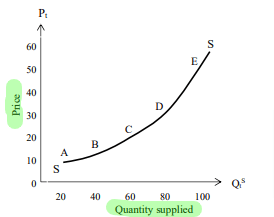25 Important Basic Elements of Supply Questions and Answers [With PDF]
The 6th chapter of our economics learning course is “Basic Elements of Supply.” In this article, we’ll learn the 25 most important “basic elements of supply” questions and their answers.
These simple questions and answers will help you quickly understand the basic concepts of supply, such as what supply is, the determinants of supply, the law of supply, supply schedules, supply curves, supply equations, changes in supply, the price elasticity of supply, and much more.
By reading this post, you can quickly prepare for economics courses and other competitive exams such as Vivas, job interviews, and school and college exams.
So let’s get started.
Basic Elements of Supply Questions and Answers
The 25 most important “basic elements of supply” questions and answers are as follows:
Question 01: What is supply?
Answer: In general, supply refers to the availability of a commodity. However, in economics, supply is the amount of a commodity that sellers are willing to sell in the market at any given time.
Question 02: What are the determinants of supply?
Answer: The following are the most important supply determinants:
- Costs of the factors of production
- Change in technology
- Price of related goods.
- Change in the number of firms in the industry.
- Taxes and subsidies:
- The goal of a business firm.
- Taxes and subsidies.
- The number of producers.
Question 03: What is the difference between supply and stock?
Answer: Many people mix up supply and stock. The quantity of a good that sellers are willing to sell at a given price is referred to as the “supply.” Inventory, on the other hand, refers to the total amount of any salable goods.
The supply is part of the inventory. If the seller wishes to ensure the supply of goods in the market, he will bring the goods from stock and sell them there. In a nutshell, the stock is the potential supply.
Question 04: What is the law of supply?
Answer: Commodity prices and supply are inextricably linked. In general, the price of a product is inversely related to its supply. That is, when the price of a product rises, the supply rises, and when the price of a product falls, the supply falls.
The law of supply is a rule that shows how supply and commodity prices work together and depend on each other.
That is, “other things being equal,” if the price of a commodity rises at any given time, the supply rises, and if the price falls, the supply falls. Other factors include the materials used to make the product, the methods used to make it, the natural environment, the prices of similar products, the length of time, the number of producers, subsidies, and so on.
Question 05: What are the three alternative ways of expressing supply?
Answer: The three alternative ways of expressing supply are as follows:
- Supply function
- Supply schedule
- Supply curve.
Question 06: What is a supply function?
Answer: The supply of any product depends on many factors. For example, prices of goods themselves, prices of production materials, prices of other related goods, changes in technical skills, taxes and subsidies, natural conditions, etc. This dependency relationship, when expressed mathematically, is called the supply function.
The general form of the supply function is Sx = f (Px, Cx, Tx)
Question 07: What is a supply schedule?
Answer: A supply schedule is a list of quantities of a commodity at different prices at a given time. According to this rule, supply is inversely related to the commodity price.
Question 08: What are individual supply and market supply schedules?
Individual supply schedules are when one company sells a good or service at different prices but keeps everything else the same.
The “market supply schedule” is the total amount of goods that all firms or producers on the market offer for sale at different prices during a certain time period.
Question 09: What is the supply curve?
Answer: When the price of a product rises, the quantity of supply rises, and when the price falls, the quantity of supply falls. When this direct change in supply in response to a change in price is represented by a curve or diagram, it is referred to as the supply curve. The supply curve is a graphical representation of the supply schedule information.

Question 10: What is the cause of the supply curve going upward from left to right?
Answer: According to the law of supply, “other things being equal,” there is a direct relationship between the price of a good and its supply. Because of the direct relationship between the price of the good and its supply, the supply curve generally slopes upward from left to right. Several other factors are also to blame. They are explained further below:
- If the cost of making a product stays the same but the price goes up, the seller’s profit goes up. That is why the supply of that solution increases. Again, when the market price of goods decreases, the production and supply of goods also decrease. This causes the supply curve to shift upward.
- Generally, when the market price of a product increases, many sellers enter the market. As a result, the supply of goods increases. Again, when the price of the product decreases, the supply of the product also decreases. As a result, the supply curve slopes upward.
Question 11: What is the exception to the law of supply?
Answer: The law of supply has the following exceptions:
- If there is a huge possibility of a price increase in the future, even if the price of that product increases slightly, the supply of that product will not increase. Because the seller will reduce the supply now in anticipation of further price increases in the future.
- There are many products whose supply is limited or inelastic. For example, even if the price of a rare painting by a famous artist increases, its supply cannot increase.
- Many times the worker prefers to rest instead of work. In such a situation, even if the price of labor increases, the supply of labor does not increase. If the supply of labor does not increase, the supply of goods does not increase. Again, if wages fall, he works harder to keep income the same, i.e., increases the supply of labor and increases the supply of goods.
- The supply rule is not applicable in the case of seasonal produce. Even if the price of a good goes down during a certain time of year, the supply of that good does not go down. Again, even if the price increases at the end of the season, it is not possible to increase the supply.
- If production stops because there aren’t enough inputs, the supply can’t go up even if the price of the product goes up.
- If natural disasters stop the production of goods, it is not possible to make more of those goods available, even if the price goes up. For example, even if the price of agricultural products goes up because of a severe drought or flood, it is not possible to increase the supply of these products.
Question 12: What is the supply equation?
Answer: The supply equation shows the relationship between the price of a good and the amount that is sold, assuming that “other conditions remain the same.”
Question 13: What are “changes in quantity supplied” and “changes in supply”?
Answer: If a change in the price of goods leads to a change in supply when “other conditions remain the same,” this means that the amount supplied has changed. That is, we can say that a change in quantity supplied means a change in position along the same supply curve.
On the other hand, a change in supply means a change in the supply curve or a decrease or increase in supply. In this case, the price of the good is fixed, and other determinants of supply affect the supply of the good.
Question 14: What are the extensions and contractions of supply?
Answer: Other things being equal, an increase in the price of a good leads to an increase in its supply, which is called an extension of supply.
On the other hand, if the price of good decreases, other things being equal, and the quantity supplied of the good also decreases, it is called a contraction in supply.
Question 15: What effect does supply have on price?
Answer: A rise in supply (a shift of the supply curve to the right) will result in a decrease in price and an increase in the volume of goods bought and sold.
A decrease in supply (a shift to the left of the supply curve) will result in a price increase and a decrease in the volume of goods bought and sold.
Question 16: What is the reason for the increase in supply?
Answer: The reasons for the increase in supply are as follows:
- Improvement of technology
- Decreasing prices of substitutes
- Reduction in cost of production materials
- Favorable changes in the intention of the producer
Question 17: What is the reason for the supply decline?
Answer: The reasons for the decline in supply are as follows:
- Technical error.
- Increase in price of substitute goods
- Increase in the cost of inputs
- An adverse change in the manufacturer’s intentions
Question 18: What is the price elasticity of supply?
Answer: The ratio or magnitude of the percentage or relative change in supply as a result of a percentage or relative change in the price of a good is called the elasticity of supply or price elasticity of supply.
The following formula is used to determine the price elasticity of supply:
ES = (% change in quantity supplied / % change in price)
Question 19: What are the various types of supply elasticity?
Answer: The following are the various types of supply elasticity:
- Unitary elastic supply
- Relatively elastic supply
- Relatively inelastic supply
- Perfectly inelastic supply
- Perfectly elastic supply
Question 20: What is unitary elastic supply?
Answer: Unitary elastic supply is the rate at which the price of a good changes if the amount supplied changes at the same rate. For example, if the price of a good rises by 20% while supply rises by 20%, this is referred to as “unitary elastic supply.”
In this case, the supply elasticity is equal to 1. [Es = 1]
Question 21: What is a relatively elastic supply?
Answer: If the percentage or relative rate of change in the amount supplied is greater than the percentage or relative rate of change in the price of a good, then the elasticity of supply is greater than one (Es > 1). It is also called a relatively elastic supply.
Question 22: What is a relatively inelastic supply?
Answer: A supply is said to be relatively inelastic if a larger change in price leads to a smaller change in the amount supplied. For instance, if the price goes up by 20%, the amount supplied goes up by less than 20%. In this case, the supply elasticity is less than 1 (Es < 1).
Question 23: What is a perfectly inelastic supply?
Answer: If there is no change in the supply of a good despite a change in its price, it is called zero elasticity. That is, even if the price changes, the supply remains constant. It is also called a perfectly inelastic supply. In this case, the supply elasticity is equal to zero (Es = 0).
Question 24: What is a perfectly elastic supply?
Answer: If there is a large change in supply with very little or no change in the price of a good, then the elasticity of supply will be infinite. It is also called a perfectly elastic supply.
In this case, the supply elasticity is equal to infinity. (Es = ~ ).
Question 25: What are the determinants of price elasticity of supply?
Answer: The following are the determinants of price elasticity of supply:
- The most important factor influencing how elastic the supply is is time.
- Compared to goods that are perishable and cannot be stored, the supply of goods that can be safely stored is relatively elastic.
- How easy it is to move production inputs from one use to another affects how elastic the supply is. When factor mobility goes up, the elasticity of the supply of the good goes up, and vice versa.
- If costs rise quickly as output increases, any increase in profitability caused by a price increase is offset by higher costs as supply increases. Supply will be comparatively inelastic if this is the case. On the other hand, if costs go up slowly as output goes up, supply is likely to be relatively elastic.
I hope you have a good understanding of the “Basic Elements of Supply“ chapter by the end of this post.
If you read these 25 important “basic elements of supply” questions and answers on a regular basis, you will gain a better understanding of the chapter.
Don’t forget to leave a comment for us if you have any questions or if you would like to find out more information.
You can also read:
- Introduction to Economics Questions and Answers [With PDF]
- Important Concepts of Economics Questions and Answers [With PDF]
- Important Theory of Consumer Behavior Questions and Answers [With PDF]
- Important Basic Elements of Demand Questions and Answers [With PDF]
- Important Theory of Production Questions and Answers [With PDF]






